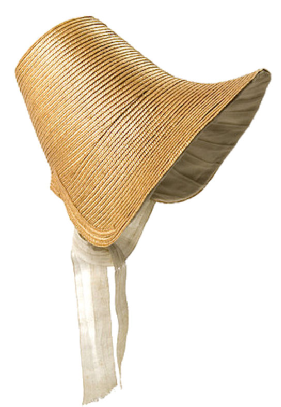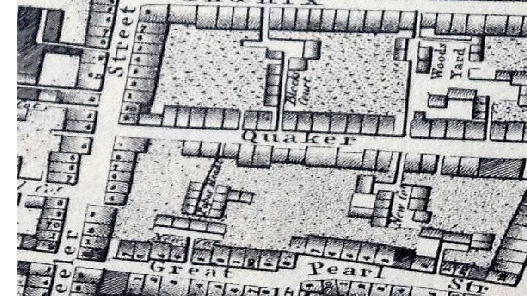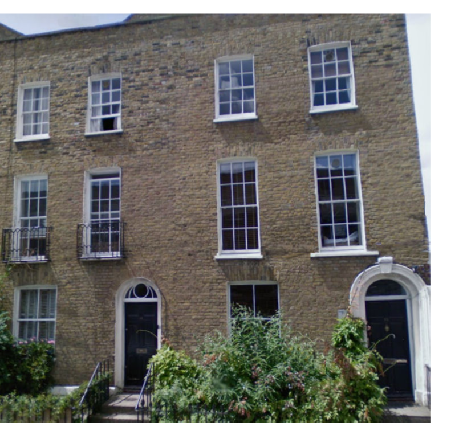Early years
 Esther was baptised on 22 March 1821 at Christ Church in the heart of Spitalfields,
the daughter of Charles Steward and Mary Ducro. Her father died in February 1824
when she was less than three years old, and although her grandmother, Ann Ducro,
had a small income, the loss of her father undoubtedly put a strain on the families
finances. As a result, from a young age, she learnt how to split and plait straw,
which was then used in the making of straw bonnets.
Esther was baptised on 22 March 1821 at Christ Church in the heart of Spitalfields,
the daughter of Charles Steward and Mary Ducro. Her father died in February 1824
when she was less than three years old, and although her grandmother, Ann Ducro,
had a small income, the loss of her father undoubtedly put a strain on the families
finances. As a result, from a young age, she learnt how to split and plait straw,
which was then used in the making of straw bonnets.
Straw plaiting was a thriving cottage industry and children as young as three were
employed, their pliant fingers well suited to the dexterous work. The heyday came
with the Napoleonic wars, when blockade and high import duties excluded foreign and
especially Italian plait. At a time when the average Hertfordshire agricultural wage
was between 10s and 12s a week, straw plaiting wives could earn appreciably more
than their husbands, and children’s contributions to the family income were considerable.
Esther’s straw plaiting, and the industry of her siblings, would have bee n an important
part of her family’s income. Unlike many children who often did not get an education
because they could “…learn the craft, and their parents are hard to convince that
paying for their schooling is necessary when they can earn a living instead" (Government
report, 1842), Esther learnt to read and write.
n an important
part of her family’s income. Unlike many children who often did not get an education
because they could “…learn the craft, and their parents are hard to convince that
paying for their schooling is necessary when they can earn a living instead" (Government
report, 1842), Esther learnt to read and write.
‘Marry in haste, repent at leisure’
Although the youngest of her siblings, Esther found a husband at a young age. Perhaps
without a father, she was eager not to end up like her three older sisters all of
whom remained spinsters. Only three months after her sister, Eliza, had married,
Esther married George Bostock. The wedding took place on 29 September 1839 at the
Church of St John the Baptist in Hackney; Esther was 18 years old.
George Bostock was a stenciller whose father, James, was on the way to becoming not
only a successful business man, but a gentleman (that is, he had an income to live
off of without having to work). No doubt Esther began married life with high expectations,
but it is likely that it did not promise all she had hoped. Her mother-in-law, with
whom George and Esther lived had a sharp tongue, and George’s father had left his
wife to live with a younger relative. There is evidence to suggest that George drunk
himself into an early grave and where there is alcoholism, domestic violence is often
not far behind. If it had not been for her five young children, Esther might have
been relieved when George died on 11 December 1853 leaving her a young widow. For
the whole of her married life, Esther had lived with her mother-in-law, and one might
have expected this arrangement to continue after George’s death; but this was not
the case. Sometime after 1854 Esther met Thomas Hockerday. He was a carpenter so
it is possible that he was an acquaintance of her husband. Although Esther was widowed
and free to marry, Thomas was still married, having married for the third time in
1854. Despite this, Esther lived with Thomas, giving birth to a daughter on 6 January
1858, who was named Emily Adelaide. Still in her thirties, perhaps Esther wanted
to make a new life for herself; or perhaps she was just desperate to get away from
her husband’s family.
Twice widowed
At  the time of Emily’s birth, Thomas and Esther were living at 5 York Street in Shoreditch,
on the edge of the notorious slum known as the Old Nichol (it is shown in the map
just above the Great Eastern Railway Station). Two years later, the family moved
to 139 Holywell Street (Shoreditch High Street), and it was here that Esther gave
birth to a son, Thomas Henry, on 28 February 1860. He was baptised at the nearby
church of St Leonard. Five years later, in 1865, the family were living at New Inn
Yard, which runs east-west from Curtain Road to Shoreditch High Street (and is shown
at the top of the map). Like York Street, it was slum housing. An article written
by John Hollingshead entitled, ‘Ragged London in 1861’ paints a vivid and depressing
picture of these locations. It is worth quoting at length here:
the time of Emily’s birth, Thomas and Esther were living at 5 York Street in Shoreditch,
on the edge of the notorious slum known as the Old Nichol (it is shown in the map
just above the Great Eastern Railway Station). Two years later, the family moved
to 139 Holywell Street (Shoreditch High Street), and it was here that Esther gave
birth to a son, Thomas Henry, on 28 February 1860. He was baptised at the nearby
church of St Leonard. Five years later, in 1865, the family were living at New Inn
Yard, which runs east-west from Curtain Road to Shoreditch High Street (and is shown
at the top of the map). Like York Street, it was slum housing. An article written
by John Hollingshead entitled, ‘Ragged London in 1861’ paints a vivid and depressing
picture of these locations. It is worth quoting at length here:
“Walk along the main thoroughfare from the parish church towards the city, peep on
one side of the hay-bundle standing at the corn-chandler's door; look through the
group of rough, idle loungers, leaning against the corner of the gin-shop, or dive
under the fluttering garments that hang across outside the cheap clothier's window,
and you will see a dark, damp opening in the wall, like the channel of a sewer passing
under and between the houses, and leading to one of the wretched courts and alleys.
You enter the passage, picking your way to the bottom, and find a little square of
low, black houses, that look as they were built as a penal settlement for dwarfs.
The roofs are depressed, the doors are narrow, the windows are pinched up, and the
whole square can almost be touched on each side by a full-grown man. At the further
end you will observe a tap, enclosed in a wooden frame, that supplies the water for
the whole court, with a dust-bin and privy, which are openly used by all…Glancing
over the tattered green curtain at one of the black windows, you will see a room
like a gloomy well…In some cases these courts are choked up with every variety of
filth; their approaches wind round by the worst kind of slaughter-houses; they lie
in the midst of rank stables and offensive trades; they are crowded with pigs, with
fowls, and with dogs; they are strewn with oyster-shells and fish refuse; they look
upon foul yards and soaking heaps of stale vegetable refuse; their drainage lies
in pools wherever it may be thrown; the rooms of their wretched dwellings have not
been repaired or whitewashed for years; … and they are often smothered with smoke,
which beats down upon them from some neighbouring factory, whose chimney is beyond
the control of the Act of Parliament… New Inn Yard, Shoreditch, is another of the
worst; and the whole line of Holywell Lane, on either side, is full of these holes
and corners.”
One of the results of these damp, polluted, unsanitary living conditions was respiratory
diseases. On 26 February 1865, Esther became a widow for the second time, when Thomas
died suddenly of chronic bronchitis. This time, Esther has two children under seven
years of age.
Making ends meet
Presumably by this stage, Esther’s life was so far removed from that of her mother
and sisters in Spitalfields that she could not turn to them for help. After her husband’s
death, Esther continued to earn her living by making straw bonnets, although doing
so became increasingly difficult; in 1865, cheap foreign plait started to be imported
from the Far East and the British industry went into rapid decline. Even so, the
1871 census shows that Esther was still working as a ‘fancy bonnet maker’. At this
time, she was living at 26 Hoxton Street, Shoreditch, with her two children by Thomas
Hockerday: Emily, who was employed as a domestic servant, and Thomas, who was working
as an errand boy; also living with them was Edwin Francis Bostock, Esther’s son from
her first marriage, by now 18 years old and a cabinet maker. This is a little surprising
given that Edwin had lived with his grandmother, Maria Antoinette Bostock, since
his father’s death, and in 1871 his grandmother was living on her own in a house
in Bethnal Green. It appears that Esther’s children had not forgotten her after all.
In 1877, Esther’s daughter, Emily, married a 20-year old boot finisher by the name
of Benjamin Fowle. The following year Edwin Francis Bostock married Mary Ann Jeffrey,
the daughter of a French polisher. Not long after, Esther, and her son, Thomas, moved
in with the Emily and her family, and Thomas learnt the trade of boot finisher, working
alongside Benjamin; Esther continued to make fancy bonnets. At the time, the family
were living at 24 Waterlow Street in Shoreditch.
This domestic arrangement clearly suited all concerned, and it endured until at least
1891 when Esther and the family were living at 6 Goring Street in Hackney, described
by Charles Booth as a “thieves nest”, although he found that the area had an “independent
and easy going” air. Esther, by now 70-years old, was still contributing to the family’s
income through her millinery skills. She also leant a hand helping her daughter care
for her seven children.
A reversal of fortunes
In the Summer of 1895, Emily died; she was only 37 years old. After burying her daughter,
Esther may have continued living with her son-in-law, Benjamin, and her grandchildren,
but within a few years, Benjamin was either married to or living with a lady called
Marion. She was a french polisher with seven children of her own and was most likely
an acquaintance of Benjamin’s eldest daughter, Emily, who was also a french polisher.
French polishing was one of the many skilled furniture-finishing trades at which
women tended to excel, working from home and often earning good wages, with no need
for a long, formal training or an apprenticeship. In the 1880s there were 250 female
french polishers in Bethnal Green and Shoreditch, and some went on to run their own
workshops. As such, many young man hoped to attract and marry a french polisher.
A few years later, Benjamin and Marion were living at 125 Great Cambridge Street,
Haggerston (now called Queensbridge Road). The only old houses remaining on the street
today are attractive three-storey (plus basement) Regency town house (pictured  on
the left). Today they are desirable properties but in 1901 there were 18 people living
in number 125: Benjamin, Marion and 12 of their children, ranging in ages from two
to twenty-one; plus a family of four that occupied two rooms. As a result, there
was no room for the 80-year old Esther either that, or Benjamin did not want his
former mother-in-law living with him.
on
the left). Today they are desirable properties but in 1901 there were 18 people living
in number 125: Benjamin, Marion and 12 of their children, ranging in ages from two
to twenty-one; plus a family of four that occupied two rooms. As a result, there
was no room for the 80-year old Esther either that, or Benjamin did not want his
former mother-in-law living with him.
Homeless and unable to earn her own living, Esther had no option but to apply to
the parish for assistance, and in 1901 she was an inmate in the Hackney Union Workhouse.
Her son, Thomas Hockerday, was living not far away at 87 Morning Lane with his wife,
Sarah, and their five children.
Esther remained in the Workhouse for the next five years, dying on 12 March 1906
of senile decay. She had lived for 85 years, many of which had been a battle for
survival. Sarah Hockerday, her daughter-in-law, registered her death.


 Esther was baptised on 22 March 1821 at Christ Church in the heart of Spitalfields,
the daughter of Charles Steward and Mary Ducro. Her father died in February 1824
when she was less than three years old, and although her grandmother, Ann Ducro,
had a small income, the loss of her father undoubtedly put a strain on the families
finances. As a result, from a young age, she learnt how to split and plait straw,
which was then used in the making of straw bonnets.
Esther was baptised on 22 March 1821 at Christ Church in the heart of Spitalfields,
the daughter of Charles Steward and Mary Ducro. Her father died in February 1824
when she was less than three years old, and although her grandmother, Ann Ducro,
had a small income, the loss of her father undoubtedly put a strain on the families
finances. As a result, from a young age, she learnt how to split and plait straw,
which was then used in the making of straw bonnets.  n an important
part of her family’s income. Unlike many children who often did not get an education
because they could “…learn the craft, and their parents are hard to convince that
paying for their schooling is necessary when they can earn a living instead" (Government
report, 1842), Esther learnt to read and write.
n an important
part of her family’s income. Unlike many children who often did not get an education
because they could “…learn the craft, and their parents are hard to convince that
paying for their schooling is necessary when they can earn a living instead" (Government
report, 1842), Esther learnt to read and write.  the time of Emily’s birth, Thomas and Esther were living at 5 York Street in Shoreditch,
on the edge of the notorious slum known as the Old Nichol (it is shown in the map
just above the Great Eastern Railway Station). Two years later, the family moved
to 139 Holywell Street (Shoreditch High Street), and it was here that Esther gave
birth to a son, Thomas Henry, on 28 February 1860. He was baptised at the nearby
church of St Leonard. Five years later, in 1865, the family were living at New Inn
Yard, which runs east-
the time of Emily’s birth, Thomas and Esther were living at 5 York Street in Shoreditch,
on the edge of the notorious slum known as the Old Nichol (it is shown in the map
just above the Great Eastern Railway Station). Two years later, the family moved
to 139 Holywell Street (Shoreditch High Street), and it was here that Esther gave
birth to a son, Thomas Henry, on 28 February 1860. He was baptised at the nearby
church of St Leonard. Five years later, in 1865, the family were living at New Inn
Yard, which runs east- on
the left). Today they are desirable properties but in 1901 there were 18 people living
in number 125: Benjamin, Marion and 12 of their children, ranging in ages from two
to twenty-
on
the left). Today they are desirable properties but in 1901 there were 18 people living
in number 125: Benjamin, Marion and 12 of their children, ranging in ages from two
to twenty-